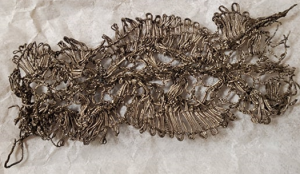Recently, an artifact in the Colonial Michilimackinac collection was re-examined as part of our ongoing mission to present the history of our site. That object is a fragment of silver-colored metallic bobbin lace that shares with us a glimpse into the luster and shine of 18th century life in the Great Lakes.
This piece of bobbin lace, likely from Europe, is made using two weights of metallic thread. Bobbin lace used many threads attached to small bobbins, which then were woven in combinations to create nearly limitless patterns. Our sample has a design of different sized fans along both edges and would have been beautiful when it was new.
 The finest laces required many hours to produce. Even after techniques for “part lace” were perfected and lace could be made in pieces by several workers, each one specializing in one type of stitch or pattern, it was still tremendously slow work. High-quality lace could be extremely expensive, but that cost was not inaccessible. People living at Michilimackinac working as merchants or officers would have considered it to be something like owning a very nice watch or a high-end handbag. Textiles were often passed on or given away as gifts when they were no longer wanted.
The finest laces required many hours to produce. Even after techniques for “part lace” were perfected and lace could be made in pieces by several workers, each one specializing in one type of stitch or pattern, it was still tremendously slow work. High-quality lace could be extremely expensive, but that cost was not inaccessible. People living at Michilimackinac working as merchants or officers would have considered it to be something like owning a very nice watch or a high-end handbag. Textiles were often passed on or given away as gifts when they were no longer wanted.
Covering oneself with glittering metallic lace, wearing silks, silver or gold embroidery, spangles (sequins) or highly polished and sparkling jewelry was a part of fashion in the eighteenth-century. The 1700s had an elegant taste for the dramatic and loved incorporating shine and movement into clothing. The example of lace shown here, could have been sewn onto many types of garments or used to trim bedclothes, pocketbooks and other household items. It was a statement of wealth and taste.
This winter, we are exploring several types of trim to add to our interpretive clothing collection. Colonial Michilimackinac will be opening on May 6, 2020 for you to come and explore. Let us share with you why we think that these glittering accessories are essential to illuminating the history of the Straits of Mackinac.









